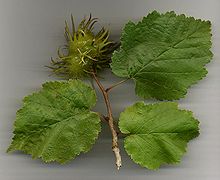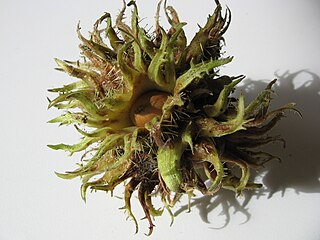Corylus colurna
| Corylus colurna | |
|---|---|

| |
| Turkish Hazel leaves and nuts | |
| Scientific classification | |
| Kingdom: | |
| (unranked): | |
| (unranked): | |
| (unranked): | |
| Order: | |
| Family: | |
| Genus: | |
| Species: | C. colurna
|
| Binomial name | |
| Corylus colurna | |
Corylus colurna (Turkish Hazel) is a tree native to southeast Europe and southwest Asia, from the Balkans through northern Turkey to northern Iran. It is the largest species of hazel, reaching 25 m tall,[1] with a stout trunk up to 1.5 m diameter; the crown is slender conic in young trees, becoming broader with age. The bark is pale grey-buff, with a thick, corky texture. The leaves are deciduous, rounded, 6–15 cm long and 5–13 cm across, softly hairy on both surfaces, and with a coarsely double-serrate to shallowly lobed margin.
The flowers are produced very early in spring before the leaves, and are monoecious, with single-sex catkins, the male pale yellow and 5–10 cm long, the female very small and largely concealed in the buds, with only the bright red 1–3 mm long styles visible. The fruit is a nut 1–2 cm long, surrounded by a thick, softly spiny and bristly involucre (husk) 3 cm diameter,[1] which encloses all but the tip of the nut; the nuts are borne in tight clusters of 3-8 together, with the involucres fused at the base.
Uses
Corylus colurna is widely cultivated as an ornamental tree in Europe and North America. It is very tolerant of difficult growing conditions in urban situations, which has increased its popularity in civic planting schemes in recent decades.
The nuts are edible, but their small size (smaller than Common Hazel nuts) and very hard, thick nut shell (3 mm thick) makes them of little or no commercial value. Corylus colurna is however important in commercial hazelnut orchards, as it does not sucker, making it the ideal rootstock on which to graft the nut-bearing Common Hazel cultivars.
Gallery
-
Without leaf.
-
Bristly involucre
-
A young Turkish Hazel planted in a city park



